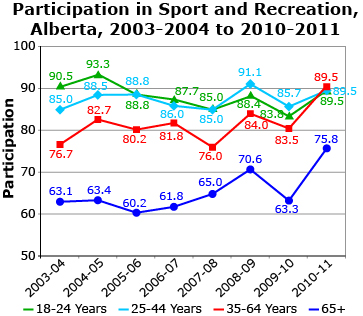Lesson 4
1. Lesson 4
1.4. Explore 3
Module 1: Probability
Warranty companies rely heavily on probability. The company will try to balance the length of the warranty with the cost of replacing products due to product failure. The longer the warranty, the happier a customer will be, but the more likely the product will need to be replaced during the warranty period.
In the next Self-Check you will look at a different example of how probability data can be interpreted to answer questions.
Self-Check 1

Alberta Tourism, Parks and Recreation: Tourism, Parks and Recreation, Survey of Albertans, 2003-2004 to 2010-2011.
<https://osi.alberta.ca/osicontent/Pages/Factsheets/ParticipationinSportandRecreation,Alberta.aspx>; (13 March 2012).
Use the information from the graph to answer the following questions.
- What is the probability that an Albertan senior (65+) participated in sport and recreation in the 2006–2007 year? Answer
- Determine the odds against a 28-year-old Albertan participating in sport and recreation in 2009–2010. Answer
- In 2006–2007 there were nearly 300 000 Albertans between 18 and 24. How many do you expect participated in sport and recreation? Answer
- Which age group is most likely to participate in sports and recreation? Explain. Answer
In Try This 2 you used probability to determine the best smartphone to buy. In Try This 3 you will use odds and probability to help interpret information about the CN Tower and to determine when to plan a trip to Toronto.
Try This 3

© Elenathewise/10709072/Fotolia
The CN Tower in Toronto was the tallest structure in the world when it was built, and is still the world�s tallest tower. It was designed to withstand lightning strikes, winds up to 418 km/h, and earthquakes up to 8.5 on the Richter scale.
-
- The CN Tower is struck by lightning about 75 times per year. Using this information, determine the odds for the tower being struck by lightning today.
- Are the odds you determined in question 1.a. reasonable? What assumptions did you make? Explain.
- During one thunderstorm, the tower was struck by lightning 24 times in 100 minutes. If you watched a one-minute video of the storm, what are the odds against you seeing lightning hit the tower?
- Are the odds you determined in question 1.c. reasonable? What assumptions did you make? Explain.
- Explain which set of odds, the yearly rate or the odds from a specific storm, better represent the likelihood of the CN Tower being struck by lightning?
- Suppose you are planning a trip to Toronto to visit the CN Tower. You hope to go on a day that it is not raining or snowing, so you can see a long distance from the observation deck. Consider the following table from Environment Canada.
Average Days of Precipitation Per Year for Toronto |
|||||||||||||
| Jan | Feb | Mar | Apr | May | Jun | Jul | Aug | Sep | Oct | Nov | Dec | Year | |
Days with Rainfall: |
|||||||||||||
| ≥ 0.2 mm | 5.2 | 4.6 | 8 | 10.9 | 12.2 | 11.1 | 10.3 | 10.5 | 10.6 | 11.4 | 10.6 | 7.4 | 112.8 |
| ≥ 5 mm | 1.8 | 1.7 | 2.8 | 4.2 | 4.7 | 4.5 | 4.1 | 4.4 | 4.7 | 4.2 | 4.3 | 2.7 | 44.1 |
| ≥ 10 mm | 1 | 0.87 | 1.4 | 2 | 2.5 | 2.6 | 2.4 | 2.4 | 3 | 2.1 | 2.2 | 1.4 | 23.7 |
| ≥ 25 mm | 0.17 | 0.07 | 0.13 | 0.33 | 0.37 | 0.47 | 0.43 | 0.80 | 0.67 | 0.27 | 0.33 | 0.20 | 4.2 |
Day with Snowfall: |
|||||||||||||
| ≥ 0.2 cm | 12 | 8.7 | 6.4 | 2.2 | 0 | 0 | 0 | 0 | 0 | 0.07 | 3.2 | 9.5 | 42 |
| ≥ 5 cm | 2.6 | 1.7 | 1.5 | 0.40 | 0 | 0 | 0 | 0 | 0 | 0 | 0.43 | 2.3 | 9 |
| ≥ 10 cm | 0.90 | 0.57 | 0.57 | 0.20 | 0 | 0 | 0 | 0 | 0 | 0 | 0.17 | 0.67 | 3.1 |
| ≥ 25 cm | 0.07 | 0 | 0 | 0 | 0 | 0 | 0 | 0 | 0 | 0 | 0 | 0.03 | 0.10 |
Day with Precipitation: |
|||||||||||||
| ≥ 0.2 mm | 15.3 | 11.7 | 12.7 | 12.1 | 12.2 | 11.1 | 10.3 | 10.5 | 10.6 | 11.4 | 12.7 | 14.5 | 145 |
| ≥ 5 mm | 4 | 3.2 | 4.3 | 4.7 | 4.7 | 4.5 | 4.1 | 4.4 | 4.7 | 4.2 | 5 | 4.5 | 52.3 |
| ≥ 10 mm | 1.7 | 1.4 | 2.1 | 2.3 | 2.5 | 2.6 | 2.4 | 2.4 | 3 | 2.1 | 2.4 | 2.2 | 27 |
| ≥ 25 mm | 0.23 | 0.13 | 0.27 | 0.33 | 0.37 | 0.47 | 0.43 | 0.80 | 0.67 | 0.27 | 0.33 | 0.30 | 4.6 |
Source: Canadian Climate Normals 1971-2000, (Environment Canada, 2011), < http://climate.weatheroffice.gc.ca> (09 March 2012).
-
What are the odds for precipitation in Toronto for any given day?
-
What are the odds against more than 5 mm of rain in Toronto tomorrow?
-
Using the yearly amounts, what is the probability that there will be more than 25 mm of precipitation tomorrow?
-
Which month has the lowest probability of receiving precipitation? Explain.
-
Which month has the highest probability of receiving 25 mm or more of precipitation? Explain.
![]() Save your responses in your course folder.
Save your responses in your course folder.
Share 3
With a partner or in a group, share your responses to the questions from Try This 3. Then complete the following questions.
- Which month is more likely to have snow, January or February? Explain how you decided.
-
- Is consulting a weather table a good way to plan a vacation when the vacation is a week away? Explain.
- How about when the vacation is a year away? Explain.
- Odds and probability provide similar information.
- When is it preferable to use each?
- Which do you prefer to use? Explain.